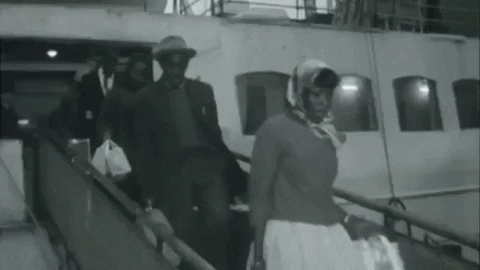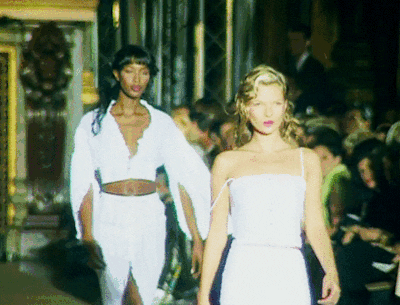
UK Black History By The Decade: 1980s
Include this article in your Skills Builder Journal. It could help you develop... 

Black history is British history. Fact.
That’s why we’re continuing our By The Decade series (check out our LGBTQ+ History By The Decade here) and focusing on recent Black history here in the UK. And we know that Black history began when the world began, but we want to champion, celebrate and educate the most recent achievements, people, stories and catalysts.
Our first venture is the 1980s.
But before we dive right in, let's take a quick look at some of the events leading up to the 80s and what that meant for the new decade.
Did you know, the first Britons had black skin, curly hair and blue eyes? This was proven after DNA analysis of a 10,000 year old skeleton, known as Cheddar Man, was done in Somerset’s Cheddar Gorge. The analysis shows he had dark curly hair and either dark or black skin, suggesting that the idea of Europeans as having fair skin is a recent phenomena. People of white British ancestry today are descendants of the Mesolithic hunters like Cheddar Man. Not only that, but at the peak of the Roman Empire, people were known to have travelled widely across the empire. By the 3rd century, there is evidence of African people making their way to Britain where they lived as soldiers, slaves and free men and women.
One of the most well known events in UK history happened in 1948, when the boat, the Empire Windrush, arrived from Jamaica. In the same year, the NHS was established, which led to a recruitment drive a few years later in the Caribbean, calling for nurses and healthcare workers, who became a large part of the workforce that built the NHS as an institution.

The 50s, 60s, and 70s saw the Black community coming together to form even stronger connections. In 1958, the Notting Hill riots exploded because of racial tensions between the West Indian communities and racist, white ‘teddy boy gangs’, who didn’t want these communities to exist. But the riots formed unbreakable bonds for Black people, especially in Notting Hill. And the next year, the famous Notting Hill carnival was founded - with an aim to celebrate the British West Indian community and encourage cultural unity.
In 1965, the Race Relation Act was passed, which aimed to protect against discrimination and made it illegal to refuse housing, public services, and employment on the grounds of ethnicity. The Act was extended in 1968 and 1976, resulting in the right to take discrimination complaints to civil courts or industrial tribunals and set up the Commission for Racial Equality.
Unity was the premise of the Rock Against Racism carnival in 1978 too which brought together Black and white teenagers who loved music and dancing. The carnival helped introduce reggae to a wider audience and changed the nature of punk. Artists like Johnny Rotten of the Sex Pistols and Big Youth from Jamaica came together to help shape British music and reflect society.
So then came the 1980s...
And while unity was still something most people strove for, there was still racial tension and rioting. The riots and uprisings against racist experiences from police raids that took place in the 80s across England - from Bristol to Brixton to Liverpool - are still considered a pivotal moment for Black communities to this day.
On 17 January 1981, at a birthday party in New Cross Road in Deptford, 13 young Black people died in a house fire. It was a widely held assumption that the fire was a racist attack, started on purpose by fascists, most likely using a petrol bomb. However, this line of enquiry was quickly dropped in favour of a theory that a fight had broken out at the party and ‘unruly Black youth’ had caused their own deaths. Survivors as young as 11 were subjected to hours of police questioning, many of whom were encouraged to sign false statements about what had happened. The outrage and despair that came from the New Cross Fire led to one of the most important and impactful events in UK history. The National Black People’s Day of Action was organised in the weeks after the fire, and on Monday 2 March 1981, more than 200,000 almost exclusively Black protestors marched from New Cross into central London as a direct response to the far right’s call to ‘keep Britain white’ and the demand for justice, not only for the young people who died, but for the Black community as a whole.
In the same year, the BBC saw a change, when Moira Stuart became the first Black, woman, newsreader on TV. And it didn’t stop there! In a career spanning over 40 years, she presented pretty much every news programme on the BBC, was the newsreader for The Chris Evans Breakfast show on BBC Radio 2, had her own music show every Sunday, became the newsreader on Classic FM and was even appointed an Officer of the Order of the British Empire in 2001!
In 1982, Olympic gold medallist Daley Thompson was voted BBCS Sports Personality of the Year and was awarded an MBE. Jump to 1984 and he won a gold medal again for the decathlon, becoming the second person in history to do so!
Bernie Grant was appointed as Britain’s first Black council leader in Haringey in 1985. After the 1987 General Election, he was one of the first three Black MPs in the House of Commons, and made his mark almost immediately by wearing a traditional Ghanaian cotton robe at the State Opening of Parliament.
Supermodel legend Naomi Campbell made history in 1986 with her first cover of American Vogue. And three years later she became the first Black woman to cover the September issue (which was also Anna Wintour’s first issue!) Since then, Naomi has been on the cover of different variations of Vogue 66 times. Woah!

1986 also saw the arrival of the Incitement to Racial Hatred Act. The Act made it an offence to use threatening, abusive or insulting words or behaviour with intent to stir up racial hatred in the street or in a public speech. And an offence to display, publish or distribute written material that is threatening, abusive or insulting with intent to stir up racial hatred.
After studying history at college, Diane Abbott decided to try and make history herself. And she succeeded! In 1987 she became the country’s first Black woman to become an MP, and continues to be the longest serving Black MP in the House of Commons! In the same year, Black History Month was made a fixture in the UK for the first time and continues to this day. Every October (right now!) Black History Month is celebrated in the UK and is a time for everyone to reflect upon, celebrate and learn about the history of Black people in our country, taking note of the achievements and contributions to the social, political, economic and cultural development of the UK.
The decade went out with a party, when Soul II Soul reached the Number 1 spot in the UK charts with Back to Life in 1989. Originally formed in 1982 by Jazzie B and Phillip ‘Daddae’ Harvey. Soul II Soul first played at street parties and youth clubs, but by the mid-1980s they had become one of the leading promoters of warehouse raves in London. Their music blended disco string arrangements with 1980s rap and hip hop and was loved (and still is) by the masses! Back to liiiiiiife, back to realittyyyy…..
The 80s showed a surge in migration of Black African immigrants, coming from countries like Nigeria, Ghana, Uganda, Kenya, Zimbabwe and South Africa. The 1991 census showed that Black Londoners made up half a million people, in a city of seven million and many were London or British born. This census was also the first to include a question on ethnicity, and the Black population of Great Britain was recorded as 890,727, or 1.6% of the total population. We’ll go into that and more in our next blog, UK Black History By The Decade: 1990s, so keep an eye out!
We’re aware that we may have missed a few things and that of course, UK Black history didn’t start in the 1980s. So feel free to let us know anything you’ve learnt and think is important to share over at @NCS!




